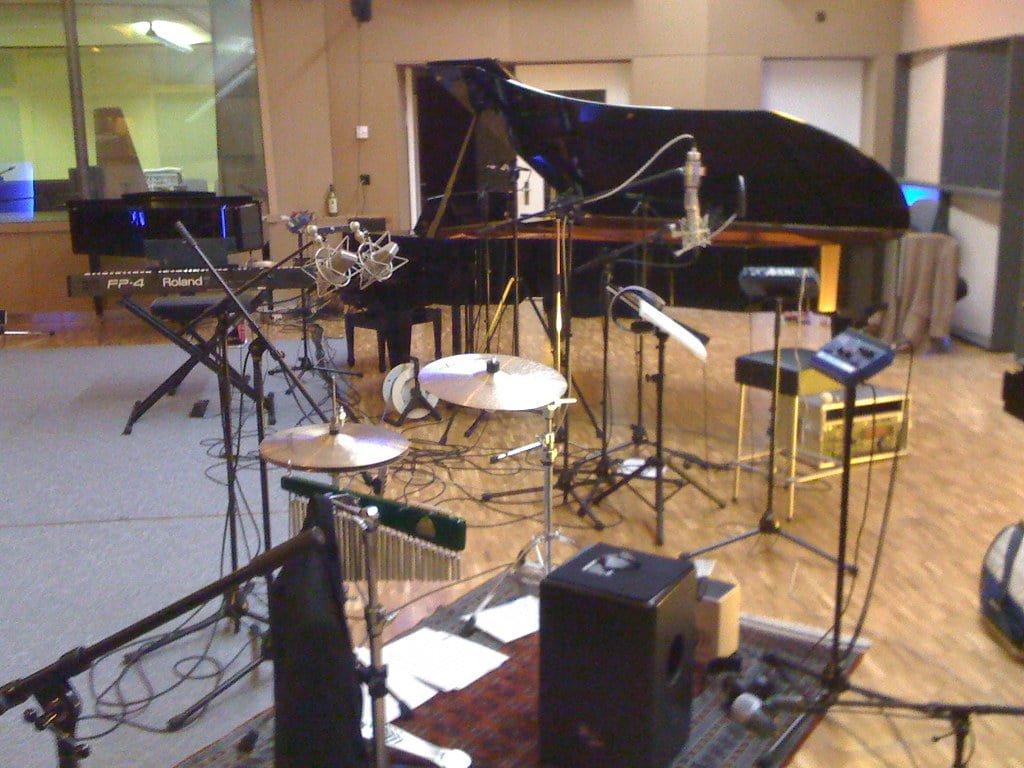Recording Acoustic Instruments: Techniques for Authentic Sound
It’s fascinating how a slight adjustment can make all the difference in capturing the essence of an instrument’s sound. But what about capturing the airiness of a flute or the resonance of a grand piano? Stay tuned as we explore various microphone techniques and room considerations that can elevate your acoustic recordings to a whole new level of authenticity and clarity.
We are supported by our audience. When you purchase through links on our site, we may earn an affiliate commission, at no extra cost for you. Learn more.
Microphone Selection and Placement
When recording acoustic instruments, selecting the appropriate microphone and placing it strategically are important steps in achieving the best sound quality. For capturing the rich tones of an acoustic guitar, microphones like the Neumann U47 Fet, KM84, Gefell M300, Peluso 84s, and Neumann KM184 are highly recommended due to their exceptional clarity and sensitivity. When it comes to mic placement, positioning the mic at the neck-body joint or over the player’s right shoulder is a commonly used technique to capture the full spectrum of the instrument’s sound.
Experimenting with different mic positions, preamps, and room setups can have a significant impact on the final acoustic guitar sound. Utilizing multiple mics and submixing for mono recording can help create a more immersive and dynamic sound. A popular setup involves placing Neumann KM184s into 1272s approximately 8-15 inches back, directing one mic towards the 12th fret and the other towards the sound hole or picking area. This configuration allows for a balanced capture of both the warmth and brightness of the acoustic guitar.
Careful consideration of mic selection and placement, along with thoughtful room setup, is essential for achieving an authentic and high-quality acoustic guitar recording.
Creating Natural Ambiance
To enhance the overall sound quality of acoustic instrument recordings, deliberate consideration of the natural ambiance within the recording environment is essential. When aiming to create natural ambiance in acoustic recordings, several key techniques can be employed:
- Room Acoustics: Choose recording spaces with natural reverb characteristics to add warmth and authenticity to the sound of acoustic instruments. The room’s acoustics play a significant role in shaping the overall ambiance of the recording.
- Mic Placement: Important mic placement is critical for capturing the natural ambiance of the recording environment effectively. Experiment with different microphone positions to find the sweet spot that best represents the acoustic instrument’s sound within the room.
- Mixing Effects: Careful adjustment of mixing effects can enhance the natural ambiance captured during acoustic instrument recordings. Reverb, delay, and EQ can be utilized to blend the direct sound of the instrument with the room’s acoustic properties, adding depth and realism to the final audio product.
Utilizing Room Acoustics
Room acoustics play an important role in shaping the tone and ambiance of acoustic instrument recordings. When considering room acoustics, one key aspect to take into account is the presence of natural reverb. This natural reverb can enhance the sound of acoustic instruments, adding warmth and depth to the recordings. On the other hand, deadened rooms, which are treated with soundproofing materials, can help reduce unwanted room reflections that might distort the sound.
The size and shape of the room also have a significant impact on the overall sound captured during recording sessions. Larger rooms tend to have longer reverberation times, which can be desirable for certain instruments and musical genres, while smaller rooms may provide a more intimate and immediate sound. The materials present in the room, such as hardwood floors or soft curtains, can also affect the sound by either absorbing or reflecting sound waves.
Proper mic placement is important when utilizing room acoustics to capture acoustic instruments authentically. Experimenting with different mic positions in relation to the room’s acoustics can help achieve the desired ambiance and sound quality. By understanding how room acoustics influence sound and making informed decisions regarding mic placement, one can create recordings that truly capture the essence of the instruments being played.
Multi-Mic Techniques
Utilizing multiple microphones in recording sessions enhances the authenticity and detail of acoustic instrument sound by capturing various nuances and tonal characteristics. When employing multi-mic techniques for recording acoustic instruments, here are some key considerations:
- Strategic Mic Placements: Placing mics at different positions around the instrument, such as close miking the guitar’s soundhole for warmth, or using overhead mics to capture the instrument’s overall resonance, can provide a more exhaustive sound picture.
- Experimenting with Polar Patterns: By selecting the appropriate polar pattern for each mic, such as cardioid, omni, or figure-8, engineers can control how much ambient noise and off-axis sound is captured, shaping the final sonic character.
- Mic Distance and Angles: Adjusting the distance between the mic and the sound source, as well as the angle at which the mic is pointed towards the instrument, allows for fine-tuning tonal balance, string definition, and overall depth in the recording.
Avoiding Phase Issues
When recording acoustic instruments using multi-mic techniques, ensuring proper mic placement and alignment is key to preventing phase issues that can impact the quality of the recorded sound. Phase problems arise when two or more microphones capture the same sound source at different times, leading to phase cancellation and comb filtering. To avoid these issues, it is essential to position microphones equidistant from the sound source and in phase alignment. Adjusting mic positions, utilizing time alignment tools, or flipping polarity can help address phase discrepancies during the mixing process.
Monitoring phase relationships between microphones is essential for maintaining a coherent and natural sound in acoustic instrument recordings. By carefully managing the phase of each microphone, engineers can prevent comb filtering effects that distort the recorded audio. Consistent mic techniques and meticulous attention to phase coherence contribute to a more authentic and pleasing sound in the final recording. Understanding the impact of phase issues and employing techniques to mitigate them ultimately result in recordings that accurately capture the nuances and dynamics of acoustic instruments.







